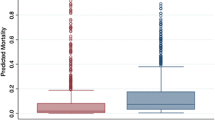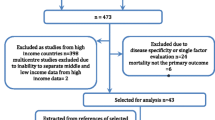Abstract
Purpose
To systematically review prognostic research literature on development and/or validation of mortality predictive models in elderly patients.
Methods
We searched the Scopus database until June 2010 for articles aimed at validating prognostic models for survival or mortality in elderly intensive care unit (ICU) patients. We assessed the models’ fitness for their intended purpose on the basis of barriers for use reported in the literature, using the following categories: (1) clinical credibility, (2) methodological quality (based on an existing quality assessment framework), (3) external validity, (4) model performance, and (5) clinical effectiveness.
Results
Seven studies were identified which met our inclusion criteria, one of which was an external validation study. In total, 17 models were found of which six were developed for the general adult ICU population and eleven specifically for elderly patients. Cohorts ranged from 148 to 12,993 patients and only smaller ones were obtained prospectively. The area under the receiver operating characteristic curve (AUC) was most commonly used to measure performance (range 0.71–0.88). The median number of criteria met for clinical credibility was 4.5 out of 7 (range 2.5–5.5) and 17 out of 20 for methodological quality (range 15–20).
Conclusions
Although the models scored relatively well on methodological quality, none of them can be currently considered sufficiently credible or valid to be applicable in clinical practice for elderly patients. Future research should focus on external validation, addressing performance measures relevant for their intended use, and on clinical credibility including the incorporation of factors specific for the elderly population.

Similar content being viewed by others
References
Moons KG, Royston P, Vergouwe Y, Grobbee DE, Altman DG (2009) Prognosis and prognostic research: what, why, and how? BMJ 338:b375
Steyerberg EW (2009) Clinical prediction models: a practical approach to development, validation, and updating. Springer, Berlin
Le Gall JR, Lemeshow S, Saulnier F (1993) A new simplified acute physiology score (SAPS II) based on a European/North American multicenter study. JAMA 270:2957–2963
Knaus WA, Draper EA, Wagner DP, Zimmerman JE (1985) APACHE II: a severity of disease classification system. Crit Care Med 13:818–829
Teres D, Lemeshow S, Avrunin JS, Pastides H (1987) Validation of the mortality prediction model for ICU patients. Crit Care Med 15:208–213
Sikka P, Jaafar WM, Bozkanat E, El-Solh AA (2000) A comparison of severity of illness scoring systems for elderly patients with severe pneumonia. Intensive Care Med 26:1803–1810
US Bureau of the Census, Cheeseman Day J (1993) Population projections of the United States, by age, sex, race, and hispanic origin: 1993 to 2050. Current population reports, US Government Printing Office, Washington, pp 25–1104
Ricou B, Merlani P (2008) What limits for acute care in the elderly? Curr Opin Anaesthesiol 21:380–385
de Rooij SE, Abu-Hanna A, Levi M, de Jonge E (2005) Factors that predict outcome of intensive care treatment in very elderly patients: a review. Crit Care 9:R307–R314
Boumendil A, Somme D, Garrouste-Org Guidet B (2007) Should elderly patients be admitted to the intensive care unit? Intensive Care Med 33:1252–1262
Ryan D, Conlon N, Phelan D, Marsh B (2008) The very elderly in intensive care: admission characteristics and mortality. Crit Care Resusc 10:106–110
Chelluri L, Grenvik A, Silverman M (1995) Intensive care for critically ill elderly: mortality, costs, and quality of life. Review of the literature. Arch Intern Med 155:1013–1022
Rodriguez-Reganon I, Colomer I, Frutos-Vivar F, Manzarbeitia J, Rodriguez-Manas L, Esteban A (2006) Outcome of older critically ill patients: a matched cohort study. Gerontology 52:169–173
Spinewine A (2008) Adverse drug reactions in elderly people: the challenge of safer prescribing. BMJ 336:956–957
O’Brien JM Jr, Aberegg SK, Ali NA, Diette GB, Lemeshow S (2009) Results from the national sepsis practice survey: predictions about mortality and morbidity and recommendations for limitation of care orders. Crit Care 13:R96
Wyatt JC (1995) Prognostic models: clinically useful or quickly forgotten? BMJ 311:1539–1541
Mallett S, Royston P, Dutton S, Waters R, Altman DG (2010) Reporting methods in studies developing prognostic models in cancer: a review. BMC Med 8:20
Mallett S, Royston P, Waters R, Dutton S, Altman DG (2010) Reporting performance of prognostic models in cancer: a review. BMC Med 8:21
Altman DG, Royston P (2000) What do we mean by validating a prognostic model? Stat Med 19:453–473
Minne L, Abu-Hanna A, de Jonge E (2008) Evaluation of SOFA-based models for predicting mortality in the ICU: a systematic review. Crit Care 12:R161
Hayden JA, Cote P, Bombardier C (2006) Evaluation of the quality of prognosis studies in systematic reviews. Ann Intern Med 144:427–437
Torres OH, Francia E, Longobardi V, Gich I, Benito S, Ruiz D (2006) Short- and long-term outcomes of older patients in intermediate care units. Intensive Care Med 32:1052–1059
Jandziol AK, Ridley SA (2000) Validation of outcome prediction in elderly patients. Anaesthesia 55:107–112
Zilberberg MD, Shorr AF, Micek ST, Doherty JA, Kollef MH (2009) Clostridium difficile-associated disease and mortality among the elderly critically ill. Crit Care Med 37:2583–2589
Nannings B, Abu-Hanna A, de Jonge E (2008) Applying PRIM (patient rule induction method) and logistic regression for selecting high-risk subgroups in very elderly ICU patients. Int J Med Inform 77:272–279
de Rooij SE, Abu-Hanna A, Levi M, de Jonge E (2007) Identification of high-risk subgroups in very elderly intensive care unit patients. Crit Care 11:R33
Nierman DM, Schechter CB, Cannon LM, Meier DE (2001) Outcome prediction model for very elderly critically ill patients. Crit Care Med 29:1853–1859
Hudson S, Boyd O (2007) Criteria for admission to the ICU and scoring systems for severity of illness. Surgery 25:117–121
Katz S, Ford AB, Moskowitz RW, Jackson BA, Jaffe MW (1963) Studies of illness in the aged: the new index of ADL: a standardized measure of biological and psychological function. JAMA 185:914–919
Mahoney FI, Barthel DW (1965) Functional evaluation: the Barthel index. Md State Med J 14:61–65
Jorm AF (1994) A short form of the informant questionnaire on cognitive decline in the elderly (IQCODE): development and cross-validation. Psychol Med 24:145–153
Charlson ME, Pompei P, Ales KL, MacKenzie CR (1987) A new method of classifying prognostic comorbidity in longitudinal studies: development and validation. J Chronic Dis 40:373–383
Malani PN (2009) Functional status assessment in the preoperative evaluation of older adults. JAMA 302:1582–1583
Fried TR, Bradley EH, Towle VR, Allore H (2002) Understanding the treatment preferences of seriously ill patients. N Engl J Med 346:1061–1066
Murphy DJ, Burrows D, Santilli S, Kemp AW, Tenner S, Kreling B, Teno J (1994) The influence of the probability of survival on patients’ preferences regarding cardiopulmonary resuscitation. N Engl J Med 330:545–549
Conflict of interest
The author(s) declare that they have no competing interests, but they note that some co-authors of this review were co-authors of two of the reviewed studies. These co-authors, however, were not involved in selecting and scoring the quality of reviewed studies.
Author information
Authors and Affiliations
Corresponding author
Electronic supplementary material
Below is the link to the electronic supplementary material.
Rights and permissions
About this article
Cite this article
Minne, L., Ludikhuize, J., de Jonge, E. et al. Prognostic models for predicting mortality in elderly ICU patients: a systematic review. Intensive Care Med 37, 1258–1268 (2011). https://doi.org/10.1007/s00134-011-2265-6
Received:
Accepted:
Published:
Issue Date:
DOI: https://doi.org/10.1007/s00134-011-2265-6




